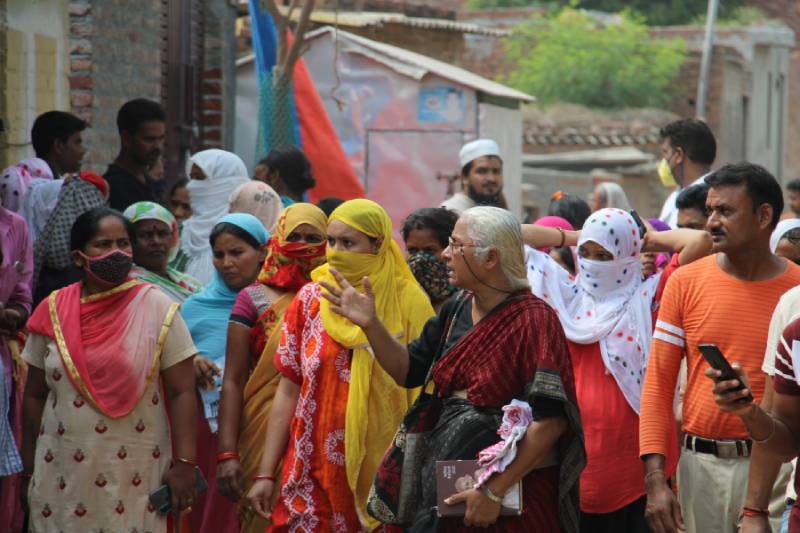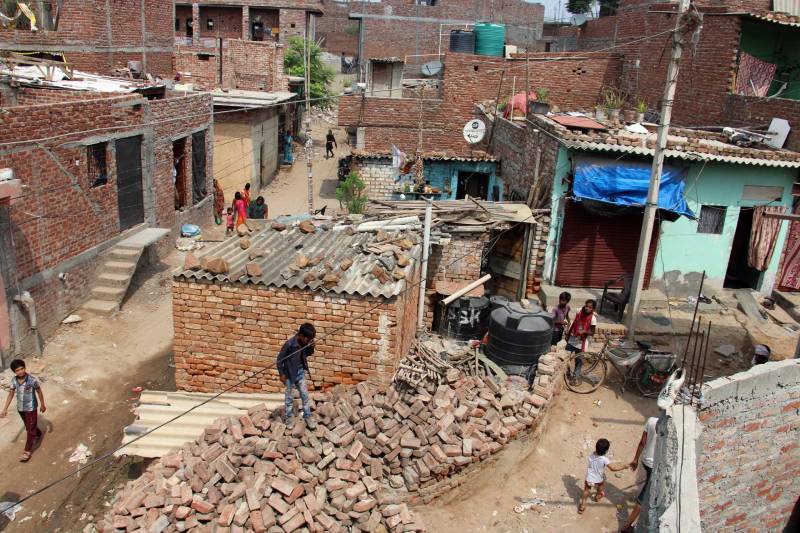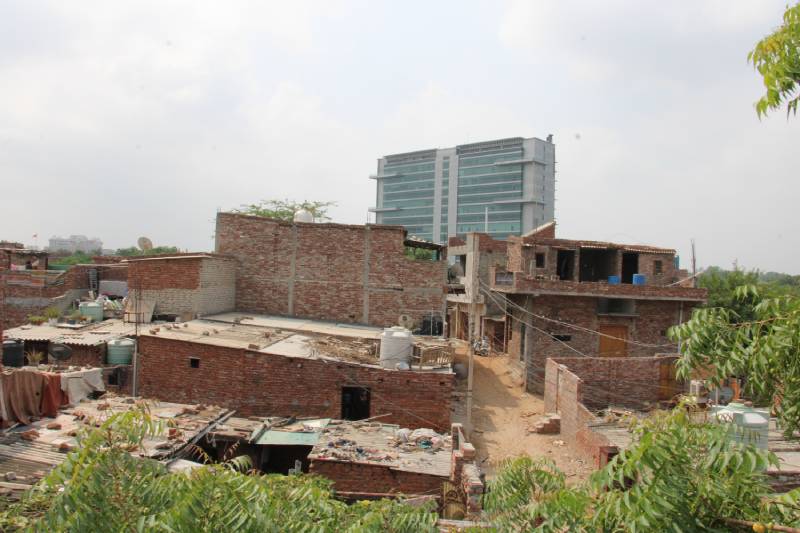Government wants to abolish poor instead of poverty, say residents of Khori village
On June 25, 2015, the Pradhan Mantri Awas Yojana – Urban (PMAY-U), a flagship mission of Government of India, was launched by Ministry of Housing and Urban Affairs (MoHUA). Exactly years later, on June 25, 2021, the residents of Khori gaon, a village on the southern fringes of Delhi, in Faridabad, Haryana, question the relevance of such a scheme.
“If the Central government is saying that it can’t go against the Supreme Court, and it can’t change its decisions, then at least they can arrange accommodation for these people. For whom did they bring the Awas Yojana (PM’s Housing for All Scheme)? Now will they do away with this scheme just like the other schemes? This scheme was for the poor, right? Where are they going to use it? They should implement it here,” Suraj, a resident of Khori village, in Faridabad, Haryana, tells Media India Group.
Agreeing with the residents’ is social activist Medha Patkar, who regularly fights for housing rights of the underprivileged and has run campaign to ensure proper resettlement for all displaced persons. Patkar addressed a press conference last week after she visited Khori Gaon and said that it is ironical that the government is demolishing over 10,000 houses and making 100,000 persons homeless, while Prime Minister Narendra Modi has promised housing for all Indians by 2022.
“On the one hand Prime Minister Narendra Modi has declared that he will provide homes to everyone by 2022. They will have to answer before 2024 about the 2022 declaration, how many houses have they demolished and how many houses have they built?” said Patkar.
Combined with its sister scheme for the rural areas, the government has committed to ‘Housing For All’ by the year 2022, with the construction and delivery of 20 million houses, 10 million each in the urban and rural areas. The objective include rehabilitation of people living in slum colonies across the country that numbered over 65 million in 2011, when the last Census was done, but which has certainly increased due to the immense migration that India has witnessed for several decades as people abandon rural areas and move to the cities in search of jobs. Government’s own estimates say that India could see the proportion of urban population jump from 31 pc in 2011 to 41 pc by 2030, rising from 377 million to nearly 600 million by 2030.
Incidentally, 2030 is also the year by which the United Nations Sustainable Development Goals (UNSDG), to which India is a signatory, seek to provide housing for all, across the world. For the residents of Khori, these seem to be little more than other ‘jumlas’ or empty promises that they say Modi has been making since he became PM in seven years ago.
Praying for miracles
Media India Group accompanied Medha Patkar on a visit to Khori where she met the residents to boost their morale. As soon as the well-known activist reached, dozens of villagers came eagerly to her, hoping that Patkar would be able to pull off the miracle that neither they nor the law firm, HRLN, that has been fighting for their rights could manage so far. On seeing Patkar, 70-year-old Razia Arfa broke down, saying, “I am so harassed after listening to this news. Even as I am talking now, I am shivering. I have just one house and I will be homeless now. I am a woman and for a woman, her honour is everything. Where will I go?”

Social activist Medha Patkar says the decision by Haryana government is totally unjust (MIG photos/Varsha Singh)
Another woman standing close to her said, “What will we be left with? If we don’t even have a roof on our heads, then we have nothing. All we have is our home that protects us. If we don’t have our homes, then we have nothing.”
Khori, in Faridabad district of Haryana, is allegedly settled on forest land. Over the years, Khori has become home to urban poor displaced from slum colonies in Delhi to make way for development projects as well as migrants from neighbouring states in search of jobs. The residents say they bought little parcels of land from dealers, almost two decades ago, through power of attorney documents.
“We have spent all our savings from the village over here. Where was the government when we were building the houses? We spent about INR 1 million on a land whose value was INR 500,000 rupees. Where was the government then? Today, when they see the land has been levelled, so are they going to run bulldozers on us?” Sahil Saifi tells Media India Group.
“Government provided water & electricity here”
They say Haryana government officials have been well aware of them as the village has power and water supplies provided by the government. In addition, the residents complain that officials from a variety of departments, including forest, police, electricity as well as water supply, have been regularly visiting them over the years, collecting well over INR 50,000 per household in bribes at stage of their stay in Khori.
“When we were constructing the houses why didn’t the government stop us then? Second thing is that people from forest department, administration officers, asked for money whenever we started the construction. Forest department officers used to come and ask for INR 5,000-10,000 or else they said that they won’t allow us live. So when we were constructing these houses, they should have stopped us then only. Now where is that administration, where is the Prime Minister and the government? Now we will force the government bow down,” says a resident, Feroz Khan.

Government’s own estimates say that India could see the proportion of urban population jump from 31 pc in 2011 to 41 pc by 2030 (MIG photos/Aman Kanojiya)
Though the government has begun issuing notices to people to move out, but the locals say they will resist any move to demolish the homes that they have built with their hard-earned money and which had for years been provided water and power supplies by the Haryana government itself.
“Nobody will go anywhere. We will starve to death in this place. Our all children and grand-children are here. Call the government and show them how the small kids are living. We even get rations. If we are not living here legally then why would the ration shop give us rations? Why do they give us these ID cards? Tell us what proof we don’t have? They have cut our electricity and water supply. And now our kids are suffering in this heat,” says a resident.
Patkar tells Media India Group that the decision of Haryana government is absolutely unjust. “The 10,000 and more families that are residing on that land, most of them had purchased land from some agents, who sold the pieces of land at the rate of INR 5,000-10,000 per square yard. And they put all their hard money into buying the houses. Now they are going to be evicted which is completely unjust.”
Abolishing the poor, instead of poverty
“They are legal voters; how can they be illegal residents. And if it is a forest land then there are a number of farmhouses as per the government itself, which are also located on the forest land. But while the Dalits, Adivasis and other underprivileged persons are considered illegal encroachers, the farmhouse owners are not. So, this is ridiculous,” adds Patkar.
“If this place comes under valley or tourism, so where was the government till now? Was the government sleeping? It’s not like that one day we came and made a slum here and started living. That’s not the case. We have paid them money for this land, our hard-earned money,” says Saifi.
Feroz Khan, another resident agrees with Saifi and blames the government for targeting the poor. “Since the BJP came to power, it has destroyed the lives of the poor people in India. They say ‘Abolish poverty’, but they are trying to abolish the poor,” he says.

The residents accuse the government of favouring the rich as the farm houses, hotels and housing complexes on the same land have not been served any notice (MIG photos/Aman Kanojiya)
Law firm HRLN that is representing the residents says that the notice was malafide as it gave the residents barely a day to move out. It says that while the court’s order is distressing, it will work with Haryana government to ensure it follows due process of law in evictions. It will also try to persuade the officials to revise their outdated rehabilitation policies.
“Mostly what we are trying to do is to ask the government to follow the procedure, because in Delhi and Mumbai there are steps which you have to take before eviction, that is they have to conduct a survey. Because if the people are evicted once it is very difficult to prove their residence at the area. There is a very detailed procedure in Delhi and in Mumbai as well, where you first conduct a survey and verify the physical presence. If you don’t so all of this people will lose their right to rehabilitation as they won’t be able to show that they were residing here. We are trying to push the Haryana government to follow the procedure for rehabilitation of those people at least who are eligible under the policy. We are also asking the government to amend the cut-off date to 2020 from the current cut-off date of 2003. So that majority of the people will be covered under the policy,” Anupradha Singh, lawyer, HRLN tells Media India Group.
For now though, the fate of these 100,000 persons hangs by a slim thread as the government says it plans to promote the site for tourism and is likely to proceed rapidly with demolitions.









